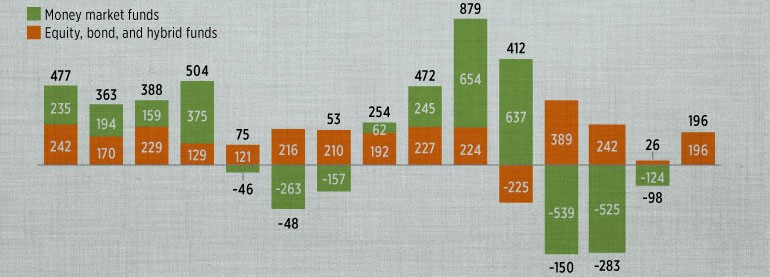Mutual Fund Categories Simplified
Post on: 22 Июнь, 2015 No Comment

In this article
- The five groups of equity funds Taxable and tax-advantaged bond funds Matching your objectives to particular categories Managing risk by diversifying fund types
With more than 8,750 mutual funds available today, selecting ones to include in your portfolio is a tricky business. 1 Overwhelmed by the sheer number of funds, new investors understandably may be confused. People invest in mutual funds mainly because they don’t have time to examine thousands of individual securities, yet selecting specific mutual funds may not be any easier.
True, picking the right funds for you will take some time. But once you have some understanding of the different fund categories that determine the kinds of securities that fund managers select for their funds, the industry’s messy and seemingly endless differentiation will often clarify itself. You can then devise a mutual fund investment strategy that will be appropriate for you, bearing in mind your risk tolerance, investment objectives, time horizon, and ability to manage fluctuations in the value of your portfolio.
Categories Of Mutual Funds
Despite the fund industry’s endless differentiation, generally, equity mutual funds boil down to five large groups: aggressive growth and small-cap funds, growth funds, growth and income funds, balanced funds, and sector funds.
Aggressive Growth And Small-Cap Funds
Are among the most aggressive equity funds. Seeking to maximize capital appreciation, these funds invest in companies with the potential for rapid growth (companies in developing industries, small but potentially fast-moving companies, or companies that have fallen on hard times but may be due for a possible turnaround). The prices of small-company stocks are generally more volatile than those of large-company stocks. Some aggressive growth funds use several investment strategies that are not suitable for all investors — which may include options and futures — in an effort to achieve superior return potential. [These funds can be very volatile in the short term, but in the long run they have the potential to outperform the broader market.] Of course, past performance is not indicative of future results. Aggressive growth funds can be appropriate for suitable long-term investors with a time horizon of 10 years or longer.
Growth Funds
Also strive for capital appreciation by investing in companies that are positioned for strong earnings growth potential. Funds in this group vary widely in the amount of risk they take. But in general, they are less risky than aggressive growth funds because they normally invest in more well-established companies.
Neither aggressive growth funds nor growth funds strive for dividend income. In fact, the companies they invest in often do not pay dividends to their shareholders but reinvest the earnings to fuel future growth.
Growth And Income Funds
Strive for both dividend income and capital appreciation by investing in companies with competitive records of dividend payments and capital gains. Of course, past performance is not indicative of future results. Most growth and income funds strive for yields equal to or better than the money market average and to provide capital appreciation that at least beats inflation. Some growth and income funds emphasize growth, while others emphasize income.
In addition, growth and income funds are generally less volatile than pure growth funds and tend to lag behind the overall market. The investment time horizon of growth and income fund investors tends to be anywhere from 2 to 10 years.
Balanced Funds
Offer one-stop shopping by combining stocks and bonds in a single portfolio. Balanced funds are generally more conservative than the previously discussed categories and usually invest in blue-chip stocks and high-quality taxable bonds. They normally hold up relatively well in rough markets, because when their stock investments fall, their bonds may do well, and vice versa. Because they offer broad diversification, balanced funds are often suitable for people with a small amount of cash to invest.
Sector Funds
Concentrate on one industry (such as technology, financial services, or consumer goods) or focus on certain commodities (such as gold, gas, or oil). Selected by more experienced investors who are willing to pay close attention to the market, sector funds are less diversified than the broader market and hence are often more volatile.
In addition, mutual funds encompass bond funds, money market funds,* and global and international funds.
Bond Funds
Can be divided into four broad categories. Within these categories, the funds are segmented by date of maturity, type of issuer, and credit quality of bonds.
- Tax-advantaged bond funds. preferred by people in higher tax brackets, buy bonds issued by state and municipal agencies.

- Taxable bond funds may invest in all other debt securities.
- High-quality bond funds stick with government and top-rated corporate or municipal bonds that offer relatively lower interest.
- High-yield bond funds buy lower-rated or non-investment-grade corporate or municipal bonds, or junk bonds, which may offer higher interest to compensate for the higher risk and volatility that investors take. Keep in mind that high-yield bonds are subject to greater loss of principal and interest, including default risk, than higher rated bonds.
Bond investments are subject to interest rate risk so that when interest rates rise, the prices of bonds can decrease and the investor can lose principal value.
Money Market Funds
Invest in short-term money market instruments, such as U.S. Treasury bills, commercial paper, certificates of deposit, and repurchase agreements. Striving to maintain a stable share price of $1.00, money market funds offer relative safety and liquidity.*
Global And International Funds
Can help diversify your assets into a wide array of foreign stocks and bonds. The difference between the two groups is that global funds may buy a mix of U.S. and foreign stocks, whereas international funds invest exclusively overseas.
Under these two fund groups, there are regional funds and country funds that take advantage of specific investment opportunities in the world’s developed and emerging countries. In terms of risk ratio, global and international funds vary widely from lower-risk funds that invest in established markets to higher-risk emerging market funds. Keep in mind that foreign investing is subject to certain risks, such as currency fluctuation and social and political changes.
There are many different types of mutual funds — each with differing objectives and exposure to risk. Below is a listing of the major types of funds that can be found under the broad asset classes of equities and fixed income. Be sure to consult a qualified financial professional to determine which funds might be appropriate for your portfolio.
*An investment in a money market fund is not insured or guaranteed by the Federal Deposit Insurance Corporation or any other government agency. Although the fund seeks to preserve the value of your investment at $1.00 per share, it is possible to lose money by investing in the fund.
Manage Risk: Diversify Fund Types
The old clichÉ Don’t put all your eggs in one basket applies to mutual funds as much as any other type of investing. By investing in only one fund category, you may subject your assets to an undue amount of risk. One way to help manage risk is to practice diversification, or spreading your assets among a variety of funds among different categories. However, please note that diversification does not guarantee a profit or protect against loss in a declining market.
Understanding mutual fund categories is only the first step in fund investing. The next step is to match your goals, time frame, and risk tolerance to appropriate fund categories. Your financial professional can help you make the most appropriate choices for you.














